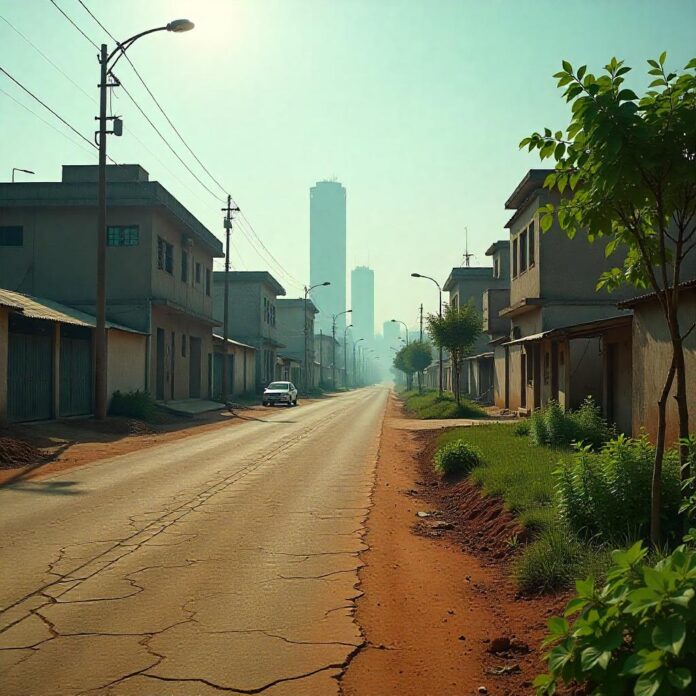Nigeria stands at a precipice: within 25 years, its cities could become unlivable heat islands plagued by floods, disease, and social breakdown. The Federal Government’s dire warning isn’t hypothetical—it’s our impending reality. With Nigeria’s urban population projected to explode to 265 million by 2050, the absence of trees, parks, and green corridors has created a catastrophic urban forest deficit. This isn’t about aesthetics; it’s about survival. As National Agency for the Great Green Wall director starkly declared: “Cities without trees are dangerously exposed to climate shocks.” This article unpacks why bridging Nigeria’s green gap is the most urgent survival issue of our generation—and how we can fight back before time runs out.
Urban Explosion, Green Extinction
Nigeria’s Hyper-Urbanization Timebomb
Our cities are swallowing Nigeria whole. By 2030, over 110 million Nigerians will live in urban areas—crossing the 50% population threshold. By 2050? A staggering 70% (200+ million) will crowd into concrete jungles. Lagos metastasizes by 600,000+ residents yearly while suffocating its green lungs. Abuja’s breakneck 8.3% annual growth comes at the cost of 30% tree cover loss in a decade. Port Harcourt’s mangroves—natural flood barriers—are vanishing as informal settlements devour them.
Decoding the Urban Forest Deficit
This isn’t just “not enough trees.” It’s a life-threatening systems failure: UN standards require 12+ trees per person; Nigerian cities average less than 1. Functional parks and corridors cover under 2% of city land versus the 15% global minimum for livability. Each lost tree means weaker flood absorption, less air filtration, and more killer heat. The deficit isn’t an inconvenience—it’s urban suicide.
The Catastrophic Consequences
Climate Amplification: Turning Cities into Kill Zones
Step outside in Abuja or Kano during dry season? You’ll face 45°C+ temperatures—5-7°C hotter than rural areas thanks to heat islands. This isn’t discomfort; it’s lethal. Remember the 2025 Mokwa floods? 200+ deaths and 3,000 displaced—directly tied to deforestation and gutted drainage. Climate disasters already cost Nigeria billions in losses. Meanwhile, northern cities like Sokoto lose 350,000+ hectares of green cover yearly, inviting desert sands to swallow communities whole.
Public Health Nightmares
Breathe in Lagos? You’re inhaling particulate matter at 10x World Health Organization limits—killing thousands yearly through respiratory disease. Stagnant floodwaters from poor drainage become cholera breeding grounds, affecting millions during recent floods. And the invisible crisis? Mental health. Studies confirm green spaces slash depression rates—a luxury nonexistent in our treeless concrete prisons.
Economic Implosion
Green deficit isn’t “environmental”—it’s fiscal sabotage: Floods annihilate roads and bridges—forcing governments to spend 97% of budgets on repairs, not prevention. Maiduguri’s extreme heat reduces outdoor work capacity by 40%—crippling construction and markets. Millions are internally displaced, with climate factors disproportionately affecting men who work outdoor jobs. Climate disasters worsen our fiscal crisis—recent deficit spikes show zero capital expenditure for prevention.
Root Causes – Why We’re Losing the Green War
Policy and Planning Failures
We’re fighting with bureaucratic blanks: Unlike global cities, Nigeria lacks laws requiring green spaces in developments. Visionary policies like “4 trees per building” gather dust without enforcement. Over 63 developing nations have National Adaptation Plans; Nigeria’s remains unfinished. Federal warnings about urban crisis lack binding requirements for states.
Financing Betrayal
The money math is catastrophic: Current climate finance represents mere pennies against billions needed annually. Adaptation receives less than 30% of funding despite causing 94% of climate losses. Most international climate finance comes as loans—worsening our debt crisis where revenue services existing debts.
Cultural and Technical Roadblocks
We’re our own worst enemy: Planners prioritize concrete over canopy, ignoring trees’ infrastructure value. No national tree inventory exists—we fly blind on carbon sequestration and coverage. Northern states plant saplings then abandon them—over 60% die within two years without watering.
Solutions – Building Nigeria’s Green Lifelines
Policy Revolution
We need laws with teeth: Enforce mandatory “4 trees per building” rule for all new constructions. Require 20% green coverage in all developments—no exceptions. Establish protected forest zones around Lagos, Abuja, and Kano using Abuja’s Millennium Park as blueprint. Finalize National Adaptation Plan with urban forests as core infrastructure with dedicated funding.
Finance Innovation
Money must flow where it matters: Convert portions of our foreign debt into urban forestry investments. Replicate successful tree initiatives via municipal bonds. Reward developers who exceed green targets via tax breaks tracked through monitoring apps.
Grassroots Green Movement
Change sprouts locally: Train youth to grow native species for neighborhood planting—Gombe State’s model shows 85% survival rates with local care. Cover bare walls in dense neighborhoods with cost-effective climbing vines—80% cheaper than new parks. Reconnect with pre-colonial traditions via school programs and media campaigns.
Technology Leapfrogging
21st-century tools for 21st-century crises: Use satellite identification of critical planting zones targeting heat islands. Convert illegal dumpsites into instant forests with modular green pods. Install moisture sensors powered by solar to sustain trees during droughts.
What You Can Do – Lifestyle Actions That Matter
The Power of Personal Green
Your balcony is a frontline: Grow snake plants or ferns—multiple species proven to slash indoor toxins in cramped apartments. Join bicycle groups demanding tree-lined lanes—reduces emissions while claiming shade. Boycott developers that clear forests; patronize businesses with green certifications.
Amplify Your Impact
Become a green insurgent: Use monitoring apps to report illegal tree cutting—pressure councils into action. Organize monthly community plantings—local care models prove high survival rates. Petition mayors to allocate 10%+ of budgets to urban forests—flood protection starts with roots. Pressure leaders at environmental summits for binding green commitments.
The 25-Year Countdown Begins Now
Nigeria’s urban future isn’t fate—it’s choice. By 2050, we’ll either drown in concrete or thrive in shade. The urban forest deficit is the battlefield for our survival, and the weapons are shovels, policies, and relentless citizen pressure. Reforestation successes prove change is possible; urban gardening initiatives show innovation is rising. This isn’t about “saving trees”—it’s about saving ourselves. Plant one tree. Convert one balcony. Challenge one official. The roots of resilience begin with you—and the time to grow them is now.


